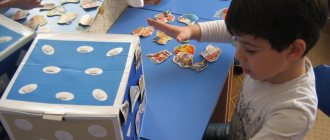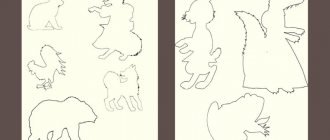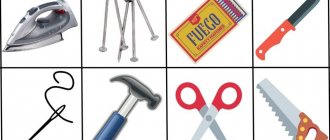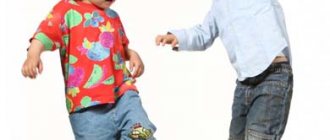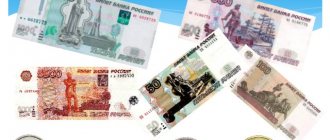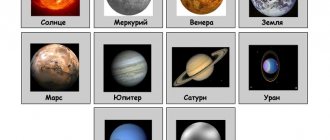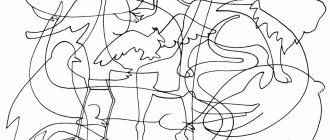Dienesha blocks for preschool children
Dienesh blocks look like three-dimensional geometric objects, reminiscent of those from which children usually build houses. However, this is not just a construction set, but material for a whole series of educational and educational games.
The set includes 48 non-repeating shapes. Each object differs from the others in at least one of 4 parameters:
- geometry - circle, square, triangle, rectangle;
- color – red, blue, yellow;
- size – large, small;
- volume - thick, thin.
That is, the set consists of 4 groups of figures of 12 pieces each. Groups of Dienesh blocks allow you to organize many exciting games that teach preschoolers to analyze, compare, generalize, and classify information. The set is supplemented with cards with illustrative, schematic and template images, as well as descriptions of tasks.
Ready-made cards and assignments are in demand; with their help, it is easier for a preschooler to get acquainted with geometric shapes. Based on the schematic image, the child makes a picture. Younger children place blocks directly on the diagram. Older preschoolers lay out the figures next to the schematic image.
The method was invented by educational psychologist Zoltan Dienes. It is an entertaining game form for developing mathematical thinking in children. According to the famous teacher, mastering mathematics is only effective when the child does not get bored. It is difficult for a preschooler to fix information in his mind when he has to listen for a long time and strain his brain. And the game method allows the child to absorb and remember information without stress and fatigue.
The method of teacher Dienesh develops mathematical thinking. For the comprehensive development of a child, it is necessary to use other teaching methods.
Dienesh's method involves 6 learning stages, depending on the age abilities of the children:
- a game without rules - the child learns to work with blocks, he develops mathematical concepts;
- playing by the rules;
- lesson with comparative analysis;
- representation – the child plays in accordance with the proposed methods, focusing on the acquired knowledge;
- creative activities conducted in accordance with logical concepts;
- formalization is that level of classes at which a preschooler is already able to draw conclusions and justifications.
Dienesh's Original Theory: Six Steps to Learning Math Concepts for Kids
Zoltan Dienes is a famous Hungarian mathematician, practicing teacher and psychologist, who radically changed the stereotypical perception of mathematics as a routine and uncreative scientific discipline. Z. Dienesh's gaming methodology is aimed at helping children of preschool and primary school age to master a variety of mathematical concepts in an entertaining way, to form and develop the most important intellectual skills and psychological processes necessary for independent logical thinking.
Personal teaching experience and knowledge in the field of developmental child psychology helped Z. Dienesh to invent and implement the concept of six steps of learning mathematics for the little ones. In addition, the theory received original methodological equipment with a complex of didactic materials in the form of additional game aids and visual logical blocks, which became an effective tool for the development of the creative and mental potential of children. The methodology is used both in official pedagogy and in the self-education system.
The use of Dienesh's logical blocks in the development of logical and mathematical thinking in preschool children
The idea of six steps for mastering mathematical knowledge and skills has undergone successful practical testing and proven its effectiveness. The substantive features of each stage received their own name:
- Free creative play. The content of this phase consists of the teacher setting a specific task for the child. In search of a solution, the child goes through spontaneous options and experimentally finds the correct answer. This is the stage of introducing the child to the task that needs to be resolved. This is how a child begins to learn mathematical wisdom.
- Rules of the game. Having overcome the stage of trial and error, the baby begins the second phase - learning the rules of the game. It is important for a teacher or parent to correctly and clearly convey to the child’s mind the most important information about the rules for achieving the desired result.
- Matching phase. Taking the third step, the child faces the need to perform the mental operation of comparison. The author of the method invites adults to test the idea of several games with similar meanings, but with different didactic material, in games with children. For example, first we play with blocks, then we cut out animal figures or lay out geometric shapes. We must see that the child independently solves the algorithm for correctly achieving the goal, regardless of the game material. In this way, you can make sure that the baby’s intellectual actions are meaningful and are not the result of mechanical memorization and automatic reproduction. This stage is necessary for the development of abstract thinking abilities.
- Introducing the abstract number symbol. At the fourth stage, various diagrams, maps and game tables will be in demand for the development of visual perception, the formation of visualization skills, and familiarization with the abstract meaning of numbers.
- Symbolic stage. The fifth step leads the child to the conclusion that the logical chains of various game series lead to a common result. To understand game cards, a special language of symbols is needed, which the child himself creates during the lessons.
- Stage of independent conclusions. The final stage will be the longest. The child, with the help of an adult, studies the meaning of the terms axiom and theorem, and independently draws the necessary logical conclusions based on the description of the rules of playing cards.
The possibilities of the manual are not limited to classes on the formation of basic mathematical knowledge; you can play Dienish games while learning English. Preschoolers post images, selecting the desired shapes and commenting on their actions (“big blue triangle”, “little yellow square”)
Dienisch developed his methodology for children in the age range from two to eight years, taking into account intellectual and psychological characteristics, so mathematical lessons are perceived with enthusiasm and passion. Adults need to be patient in studying the theoretical part of the method, as well as understand the set of teaching aids. The child’s developed ability to quickly and freely cope with complex mental exercises will be a worthy reward for parents and educators for their diligence and perseverance.
Goals and objectives
Young children have no problem mastering arithmetic, but they struggle with abstract thinking. When searching for information, a child tends to rely on patterns, but this does not always work out. Dienesh invented a technique through which preschoolers learn about abstract concepts by visualizing them. Dienesh's math blocks are an easy-to-understand and fun way to prepare for school.
The purpose of Dienesh's games is to develop logical and mathematical thinking among kindergarteners and primary schoolchildren.
Tasks:
- training in the skill of analyzing forms, comparing them according to certain parameters;
- creative and intellectual development;
- developing the ability to think logically, build chains of thoughts, and make assumptions;
- formation of responsibility, perseverance, diligence;
- speech development, expansion of individual vocabulary.
The use of Dienesh blocks is relevant in kindergartens and grades 1-2 of primary school. That is, classes are intended for children 2-8 years old.
How to play with LBD?
There is a small manual in the box with the blocks, which is very schematic. You can get acquainted with logical blocks in detail using the books: “Let's Play” (edited by A.A. Stolyar. - M., 1991, 1996), as well as “Logic and Mathematics for Preschoolers” (edited by Z.A. Mikhailova - St. Petersburg, 1996, 2000).
I will share my own experience of working with children as a methodologist - practice manager and home teacher.
All games and game exercises can be divided into 4 groups with gradual complication:
- to develop the skills to identify and abstract properties;
- to develop the ability to compare objects according to their properties;
- for the development of classification and generalization actions;
- to develop the ability to perform logical actions and operations.
All games and exercises, with the exception of the fourth group (logical), are not addressed to a specific age. After all, children of the same calendar age can have different psychological ages. Some of them reach the next stage in intellectual development a little, and some much earlier than other peers, but everyone must go through all these steps. If the child cannot cope with the task on his own, then it is necessary to simplify the task, and so on until the child solves the problem. An independent and successful decision will be the step from which you should start moving forward.
If you keep children at a certain level or give them more complex games and exercises prematurely, then interest in activities will disappear. Children are drawn to mental tasks when they are difficult for them, but doable.
It is good for an adult to become an equal partner during games. He didn’t edify, he played! Before starting games and exercises, let the child independently use them at his own discretion in games. As a rule, children are happy to build something out of them. During such games with blocks, the baby will establish that they have different shapes, colors, sizes and thicknesses. When communicating with a child, it is better to use the word “figure” than the word “block”.
Junior group
For children of a younger age group, primitive games are suitable, in which you need to group and separate objects according to parameters.
Find the same one
The teacher shows the figure. The player must find the same object based on one parameter: geometry or color. For example: a yellow triangle is shown. This means you need to find either red and blue triangles, or other yellow shapes.
Find something different
The opposite of the previous task. It is required to find figures that differ from the demonstrated element in a certain parameter: size, color, geometry.
Plant in the beds
For the game you need to prepare improvised beds. The blocks will be vegetable seeds. The teacher gives the task to plant the seeds in certain beds. For example, for the first bed - small and red, for the second - square and yellow.
Feed the toys
To play, you need to place dolls or soft toys on the table. Dienesh blocks will be food. The teacher explains that toys want to eat, but each of them has its own food. For example, a teddy bear eats large yellow figures, and the Masha doll eats small blue ones. The players’ task is to choose the right blocks for each toy.
Games with hoops
Goals:
- Formation of the operation of classifying blocks according to two, three, four characteristics using codes and without them.
- Determining intersection areas in hoop games.
- Development of logical thinking and attention.
Developmental environment:
- hoops,
- sets of blocks.
We define each of the areas and the area of their intersection:
- the first area should contain all the yellow pieces;
- in the second area - everything is round;
- in the third - only yellow round ones.
Middle group
Middle age preschoolers can play with diagrams and pictures. It is advisable to choose creative games with Dienesh blocks so that students use their imagination as much as possible.
Game with pictures
To play, you need to buy or print color pictures depicting different objects in a geometric representation. The child’s task is to correctly place the blocks on the picture. For example, the car wheel shown is a circle. This means you need to apply a round block.
Build a row
The game greatly develops the ability to analyze.
You need to place several blocks so that a clear sequence is formed. The player must understand which piece to place next. For example, a red circle followed by a blue one. Therefore, the third one will be the yellow circle. Or this combination: circle, square, triangle - all red. This means that the fourth figure will be a red rectangle.
What's extra
The game teaches you to group objects according to certain characteristics.
The teacher lays out 3 or 4 figures in front of the child. One should be superfluous, that is, not having a single common feature with the others. The player must point to the wrong object and explain his decision.
When the child begins to cope with it with ease, complicate the task: put 6 figures, of which two should be incorrect.
Point to an object with "not"
The teacher lays out the blocks and names signs with negation. And children must point to the corresponding objects. For example, “this figure is not red” or “this is not a triangle.”
Fix the bridge
To play, you need to prepare cards depicting geometric shapes, indicating their colors and sizes. And also similar cards, but with crossed out images, meaning that the block should not have such signs.
The teacher tells a story about how a bridge broke between the houses of two fairy-tale characters, and the neighbors can no longer see each other. The students' task is to repair the bridge. Only the “bricks” need to be laid not at random, but according to a certain rule, then the structure will be strong and will no longer break.
Next, the teacher shows 1-2 cards with parameters, and the children choose the appropriate “bricks”. For example, cards are shown with a crossed out triangle and an uncrossed red color. This means that the next “brick” for the bridge must be red, but cannot be a triangle.
Which figure disappeared
The game strengthens memory and concentration.
The teacher lays out several blocks in a row. The child tries to remember the sequence, then closes his eyes. The teacher removes one element of the sequence. The pupil, having opened his eyes, must remember what figure was in the place where it is now empty.
The game can be a little more complicated: do not leave an empty space, but replace the removed block with another. Then the player’s task becomes to return a number of figures to their original form. If the child copes well, you can complicate it even more: replace not one, but 2-3 objects.
Constructor
Children love to play with Dienesh blocks as if they were construction sets. This game develops imagination and creative thinking.
Children construct something at the suggestion of the teacher or at their own request. To begin, have students practice constructing using a visual diagram. Then they must use their imagination.
Card index of games with Dienesh blocks
Zakevich Natalya
Card index of games with Dienesh blocks
Didactic game "Find"
Tasks:
1. Introduce logical blocks
2. Fix the name of geometric shapes, primary colors, the concepts of “big - small”
,
“thick - thin”
3. Develop the ability to compare geometric shapes with each other, identifying a common feature and finding a figure based on a given feature.
Material: Dienesh Logic Block
Progress of the game: The teacher gives the children tasks - “Find all the figures ( blocks like this one by color (size, shape)
.
Find a figure that is different from this one in color (shape, size)
.
Find all the shapes like this one by color and shape (by shape and size, by size and color)
.
Find shapes that are different from this one by color and size (by color and shape, by shape and size; by color, size and shape)
. Find the same color as this one, but a different shape, or the same shape, but a different size, or the same size, but a different color. Find the same figure as the presented one in color and shape, but different in size (same in size and color, but different in shape; same in shape and size, but different color).
Didactic game "Wonderful bag" -1
Objectives: To consolidate children’s knowledge of geometric shapes and the ability to guess objects by touch.
Material: Bag, set of Dienesha blocks .
How to play: All the figures are put into a bag. Ask your child to touch all the round blocks (all the big ones or all the thick ones)
. Then all square, rectangular, triangular.
Didactic game "Wonderful bag" -2
Objectives: To consolidate children’s knowledge about geometric shapes, their size and thickness, and the ability to guess objects by touch.
Material: Bag, set of Dienesha blocks .
Progress of the game: All figures - blocks are put into a bag. The child takes a figurine out of the bag and characterizes it according to one or more characteristics. Or names the shape, size or thickness without removing it from the bag.
Didactic game “What has changed”
Tasks:
1. Improve children’s knowledge about geometric shapes, their color, size, thickness
2. Develop logical thinking and memory
Material: Dienesha block .
Progress of the game: Several figures are laid out on the table in front of the child that need to be remembered, and then one of the figures disappears or is replaced with a new one, or two figures are swapped. The child should notice the changes.
Didactic game “Find the wrong one”
Tasks: Continue introducing logical blocks .
Progress of the game: Place any figure in front of the child and ask him to find all the figures that are not the same as this one in color (size, shape, thickness)
.
Didactic game “Continue the row”
Tasks:
1. To consolidate children’s knowledge about geometric shapes, color, size, thickness
2. Develop logical thinking
Material: Dienesha block
How to play: We lay out a chain of Dienesh blocks so that there are no figures nearby that are the same in shape and color (in color and size; in size and shape, in thickness and color, etc.)
. We invite the child to continue the row of figures.
Didactic game "Find a pair"
Tasks:
1. Improve children’s knowledge about geometric shapes, their color, size, thickness
2. Develop thinking.
Material: Dienesha block .
Progress of the game: Invite the children to find a pair for each figure, for example, by size: a large yellow circle will be paired with a small yellow circle, a large red square will be paired with a small red square, etc.
Didactic game “Second Row”
Objectives: Develop the ability to analyze, highlight the properties of figures, find a figure that is different in one way.
Material: Dienesh Logic Block .
How to play: Place any 5-6 pieces in a row. Build a second row under them, but so that under each figure in the top row there is a figure of a different shape (color, size)
;
same shape, but different color (size)
; different in color and size; not the same in shape, size, color.
Didactic game “Game with one hoop”
Objectives: Develop the ability to split a set of one property into two subsets, perform the logical operation “not”
.
Material: Hoop, set of Dienesh logic blocks .
Progress of the game: Before starting the game, find out which part of the game sheet is inside and outside the hoop, set the rules: for example, arrange the pieces so that all red pieces (and only them)
found themselves outside the hoop. After all the figures are located, two questions are asked: which figures lie inside the hoop?
Which pieces were outside the hoop? (The answer is assumed: “all non-red figures lie outside the hoop”
).
As the game repeats, children can choose which blocks to put inside the hoop and which ones outside.
Didactic game “Game with two hoops”
Objectives: Developing the ability to split a set according to two compatible properties, perform logical operations “not”
,
“and”
,
“or”
.
Material: 2 hoops, set of Dienesh logic blocks .
Progress of the game: before starting the game, you need to find out where the four areas are located, defined on the game sheet by two hoops, namely: inside both hoops; inside the red but outside the green hoop; inside the green hoop but outside the red hoop and outside both hoops (these areas need to be circled with a pointer)
.
1. then the rule of the game is called. For example, arrange the figures so that all the red figures are inside the red hoop, and all the round ones are inside the green hoop.
2.after solving the practical problem of arranging the figures, the children answer the questions: which figures lie inside both hoops; inside the green but outside the red hoop; It is advisable to play the game with two hoops many times, varying the rules of the game.
Didactic game “Find the right block ”
Tasks:
1. Introduce children to cards of blocks depicted
2. Develop logical thinking, the ability to encode and decode information
Material: Set of logical blocks of Dienesh , cards - property designations.
Progress of the game: Children look at cards on which the properties of blocks (color, shape, size, thickness)
.
Then the child is presented with a card and asked to find all the same blocks and name them. Game exercises with two or more cards .
Didactic game “Find the right block 2 ”
Objectives: Develop logical thinking, the ability to encode and decode information
Material: Set of logical blocks of Dienesh , cards with negation of properties.
Progress of the game: Children look at cards on which the negations of the properties of blocks (color, shape, size, thickness)
.
Then the child is presented with a card and asked to find all the same blocks and name them. Game exercises with two or more cards .
Didactic game “Treat for bear cubs 1”
Objectives: Developing the ability to compare objects according to one or four properties, understanding words: “different”
,
“identical”
Material: 9 images of bear cubs, Dienesh blocks .
Progress of the game: Bear cubs came to visit the children. What will we treat our guests to? Our cubs have a sweet tooth and really love cookies, of different colors and shapes.
Let's give the cubs a treat. The cookies in the left and right paws should differ only in shape (color, size, thickness)
.
“cookie”
in his left paw , his right paw may have a square, or rectangular, or triangular
(not round)
.
In all options, the child chooses any “cookie” block
in one paw, and picks it up with the other according to the rule proposed by the teacher.
Didactic game “Treat for the bear cubs 2”
Objectives: Developing the ability to compare objects according to one or four properties, understanding words: “different”
,
"the same"
.
block codes .
Material: 9 images of bear cubs, Dienesha blocks .
Progress of the game: Variant of the game using cards with property symbols . Sequence of actions (algorithm)
games.
Cards with property symbols are placed in a stack of “backs”
up
The child takes any card
Finds "cookies"
with the same property, etc.
Didactic game “Guess what figure I wished for”
Objectives: Develop logical thinking, the ability to encode and decode information
Material: Set of logical blocks of Dienesh , cards - designations of properties, cards with negation of properties
Progress of the game: The teacher lays out in front of the child a set of cards describing a block . The child finds the desired block and a block using
Didactic game "Artists"
Objectives: Develop the ability to compare figures by their properties, develop artistic abilities (choice of color, background, location, composition)
.
Material: “Sketches of paintings ”
- sheets of large colored
cardboard ; cardboard parts to compose the composition of the picture ; set of blocks .
Progress of the game: Children are invited to “paint pictures ”
according to sketches.
Several people
can “paint” one Children choose a “sketch” of the painting , paper for the background, details for the future painting , and the necessary blocks . If the part is only outlined in the sketch (the outline of the part)
, a thin
block ; if the part is painted, a thick block . So, for example, for a sketch of a picture with elephants, a child will take additional details: 2 elephant heads, the sun, a lake, the top of a palm tree, a cactus, an animal and blocks . At the end of the work, the artists come up with a title for their paintings .
Didactic game "Shop"
Objectives: Develop the ability to identify and abstract properties, the ability to reason, and justify your choice.
Material: Product ( cards with images of objects)
. Logical figures.
Progress of the game: Children come to a store where there is a large selection of toys. Each child has 3 logical figures “money”
.
With one “money”
you can buy only one toy. Purchase rules: you can only buy a toy that has at least one property of a logical figure.
The rule can be complicated by choosing a toy based on two properties (for example, a large square, a blue square, etc.)
Didactic game “Compare - where is more”
Objectives: To improve children's knowledge about geometric shapes, their color, size, thickness. Strengthen counting from 1 to 10, practice the ability to equalize multiple blocks . Develop thinking.
Material: Dienesha block .
How to play: 3 Dienesh blocks , and 4 in the other. Ask your child where there blocks and how to equalize them. The number of blocks depends on the age of the children and their level of development.
Didactic game “What has changed”
Objectives: Improve children's knowledge about geometric shapes, their color, size, thickness. Develop thinking.
Material: Dienesha block .
Progress of the game: Several figures are laid out on the table in front of the child that need to be remembered, and then one of the figures disappears or is replaced with a new one, or two figures are swapped. The child should notice the changes.
Didactic game “Continue the row”
Objectives: To consolidate children's knowledge about geometric shapes, color, size, thickness. Develop thinking.
Material: Dienesha block .
Progress of the game: We lay out the figures one after another on the table so that each subsequent one differs from the previous one in just one attribute: color, shape, size, thickness. Invite the child to create his own series of figures, following the rule.
Didactic game "Chain"
Objectives: Develop the ability to analyze, highlight the properties of figures, find a figure based on a given characteristic.
Material: Set of logic blocks of Gyenish .
Progress of the game: From a randomly selected figure, try to build as long a chain as possible. Options for building a chain:
• So that there are no figures of the same shape nearby (color, size, thickness)
;
• So that there are no figures nearby that are identical in shape and color (in color and size, in size and thickness, etc.)
;
• So that there are figures nearby that are the same in size, but different in shape, etc.;
• So that nearby there are figures of the same color and size, but different shapes (same size, but different colors)
.
Didactic game “Find the right block ”
Objectives: To develop logical thinking, the ability to encode and decode information.
Material: Set of logical blocks of Dienesh , cards - property designations.
Progress of the game: Children look at cards on which the properties of blocks (color, shape, size, thickness)
.
Then the child is presented with a card and asked to find all the same blocks and name them. Game exercises with two or more cards .
Didactic game “Find the right block 2 ”
Objectives: To develop logical thinking, the ability to encode and decode information.
Material: Set of logical blocks of Dienesh , cards with negation of properties.
Progress of the game: Children look at cards on which the negations of the properties of blocks (color, shape, size, thickness)
.
Then the child is presented with a card and asked to find all the same blocks and name them. Game exercises with two or more cards .
Bibliography:
1. Z. A. Mikhailova, E. A. Nosova Logical and mathematical development of preschool children: games with Dienesh logic blocks and Cuisenaire colored sticks. – SPb.: PUBLISHING HOUSE “CHILDHOOD PRESS”
, 2015. – 128 p., ill.
– (Methodological set of the program “Childhood”
).
2. Z. A. Mikhailova Game tasks for preschoolers. – SPb.: PUBLISHING HOUSE “CHILDHOOD PRESS”
, 2015. – 144 p., ill.
– (Library of the program “Childhood”
).
3. E. A. Nosova, R. L. Nepomnyashchaya Logic and mathematics for preschoolers. -WITH. -Petersburg: Publishing house "CHILDHOOD PRESS"
, 2000.
Senior group
Dienesh's logic blocks help kindergarteners preparing for school to improve their math skills. Children learn to count, compare, and contrast.
House
To play, draw a diagram of a house. In every room there lives a geometric figure, you need to draw it there. Certain blocks should not live in some rooms; crossed out figures should be drawn there. The pupils’ task is to correctly distribute the blocks among the rooms.
Shop
Make a makeshift store for the game. Let the goods be toys, treats, and stationery. And money is Dienesh’s blocks.
The teacher distributes blocks to the children. Then he says which product costs how much. For example, for a teddy bear you need to pay two triangles. A child, looking at his “money,” understands whether he can afford to buy this product.
Price requirements should gradually become more complex. First, the colors of the blocks are added to the price, then the sizes. For example, “for a doll you need to pay a blue rectangle” or “a box of pencils costs two large circles of yellow and red colors.”
Domino
Blocks are distributed equally between players. The first participant, chosen by lot, places a piece on the table. The next player must place a block that matches the first one in one of the indicators: color, shape or size. If there is no such block, you will have to skip a move. The winner is the player who gets rid of all his pieces first.
Christmas tree
The game develops the skill of counting in order and navigating through schematic images. For this lesson you need to prepare a picture of a Christmas tree and 15 character cards. Dienesh blocks will be Christmas balls.
To decorate the spruce, 15 balls are used: 5 rows of 3 pieces. On the cards, numbers indicate row numbers, and one of the 3 circles filled in indicates the location of the ball in the row. At the bottom of the picture it is indicated which geometric figure will represent a particular Christmas ball.
Find the treasure
The teacher places blocks in front of the player. The child turns away so that the teacher can hide a coin under one of the laid out objects. To find the treasure, the player asks questions. For example: “Treasure under the red block?” The presenter answers: “No.” This means that red objects are excluded; there is no coin under them. Next: “Treasure under the round block?” Host: “Yes.” This means you need to look among the round shapes. And so on until the treasure is found. Having found the treasure, the player himself becomes the leader, hiding the coin for another participant.
Gifts for animals
To play, you need to place three hula hoops on the floor so that they intersect. Next to each circle, plant a soft toy, for example, a bunny, a bear, or a fox.
The teacher explains to the students that the animals quarreled over the gifts and cannot share them. The bunny wants small ones, the fox wants triangular ones, and the bear cub wants fat ones. Only some gifts are small, triangular, and thick. Because of them, the animals argue. The children’s task is to distribute the blocks so that the controversial ones lie at the intersections of the hula hoops.
Journey
For an exciting game, you need to prepare the playing field: there is one start, then the path branches into many paths. At the beginning of each path there should be a road sign indicating which block can follow it. If the block is prohibited from passing, it will have to take another path.
For example, at first the road splits in two: large blocks go along the left branch, small blocks go along the right. Next comes the branching by color. It is advisable that at the end of each path some interesting place is drawn - the final goal of the trip: a school, a cafe, a beach, a store, a pharmacy.
Didactic material by Z. Dienesh
Author's logic blocks will introduce your child to the world of shape, color and size during casual mathematical play. The value of the didactic material of Z. Dienis:
- The most important psychological indicators of the development of logic and concentration, imagination, non-standard thinking and memory will receive an additional incentive for development.
- Working with the author's visual aids will develop speech, develop analysis and systematization skills, teach how to summarize information, and reveal the child's creative potential.
Each figure is characterized by four properties. The main goal is to teach the child to solve logical problems involving partitioning by properties
Flat version of Dienesh blocks. The kits can be widely used for: introducing children to standards of forms, teaching actions with standards. Cubes whose sides contain coded properties (shape, color, size, thickness) and the negation of properties (crossed out sign) Cubes whose sides contain properties, negation of properties. as well as numbers from three to eight Cards contain encoded information about the properties of an object The child takes a card with an example, solves it by decoding and selects the corresponding block
Schemes for making cakes The child places the selected block on the diagram with images of objects under the number that he determined as a result of solving the example on the card
The game “find a house for a lost figure”, in some houses one figure can live, in others - several Each ball is selected by solving a symbol card Correct decoding of information will allow you to select the necessary blocks and figures
Each page of the album is an illustration on which the child will have to place blocks of the appropriate color, size and shape according to the example: Option 1 - offer to move one resident into each apartment, Option 2 - two residents into each apartment. You can easily draw such a diagram yourself
This is how you can draw a symbol card by hand
At home, the album can be replaced with regular coloring
Scheme for making logical figures
Parameters of the sides of logical figures
Math blocks
The classic set of teaching blocks includes 48 parts of various colors, sizes and shapes. The elements are made in accordance with the main list of geometric shapes and have the following characteristics:
- Four block shapes: square, round, triangle and rectangle;
- Three color options: blue, red and yellow.
- Two thickness options: thick, thin;
- Two size options: large, small.
It is also fundamentally important that the set does not contain identical geometric blocks.
Video: Gyenes Logic Blocks
https://youtube.com/watch?v=CV_PU3fUuf0
Logical figures
One set for organizing classes in a small subgroup contains 24 flat figures, which include an equal number (6 elements each) of squares, triangles, rectangles and circles, as well as blocks of different colors (red, yellow, blue) and size (large, small). A visual aid with logical figures is necessary for working with the concept of a form standard and learning to manipulate standards.
Logic cubes
Cubes, the sides of which contain a coded image of characteristics (shape, color, size, thickness) and the negation of properties (a crossed out sign), as well as a cube with numbers from three to eight on each side. This didactic material is important for mastering the mental operations of substitution, symbolic encryption, decoding, and spatial modeling. The originality of logic cubes lies in the variability of the spontaneous choice of properties, which is made by tossing the cube, and this always causes delight and interest in children.
To complete the task, the child must master the skills of decoding the symbols depicted on the faces of the logic cube
Cards with symbolic transmission of information about the properties of an object, as well as arithmetic examples.
- It will help the child to master the cultural tradition of symbolic, encoded in a symbol, transmission of information about the characteristics of an object.
- Will develop the ability to perform abstract mental operations and decipher symbols.
- Builds mental arithmetic skills.
Albums, algorithmic schemes
The goal is to teach the child to strictly follow the rules and strictly follow the prescribed sequence of steps. Schematically indicate the path that needs to be taken to solve the problem.
Ribbons or hoops can serve as additional didactic tools for defining the playing area; with their help, you can expand the range of exercise options, make them more varied and exciting.
Do-it-yourself materials by Z. Dienis
Most of the games can be played using flat figures, and they can be cut out of cardboard, colored paper, painted with colored pencils or paints; variants of card schemes can also be invented independently, by analogy with ready-made ones, and drawn by hand. If it is difficult to find sets of additional cards or albums on sale, then you can print algorithmic or digital cards or album options on a color printer.
Each page of the album is an illustration on which the child will have to place blocks of the appropriate color, size and shape according to the pattern. The pictures are structured according to the principle “from simple to complex” - at the beginning there are pictures consisting of a minimum number of details
What are Dienes blocks
This is the name of a special didactic manual for mastering mathematics, developed by a famous Hungarian scientist.
Zoltan Gyenes devoted his entire life to this discipline. He tried to make it as understandable and interesting as possible for children. For this purpose, he specially developed the author's Dienesh system for the early development of mathematics by children. The game manual is a set of 48 geometric shapes. They are represented by elements, among which there are no repetitions. The figures are divided according to the following criteria:
- Color. Blue, red, yellow.
- Size. Small, big.
- Thickness. Thick, thin.
- Form. Circle, triangle, square, rectangle.
